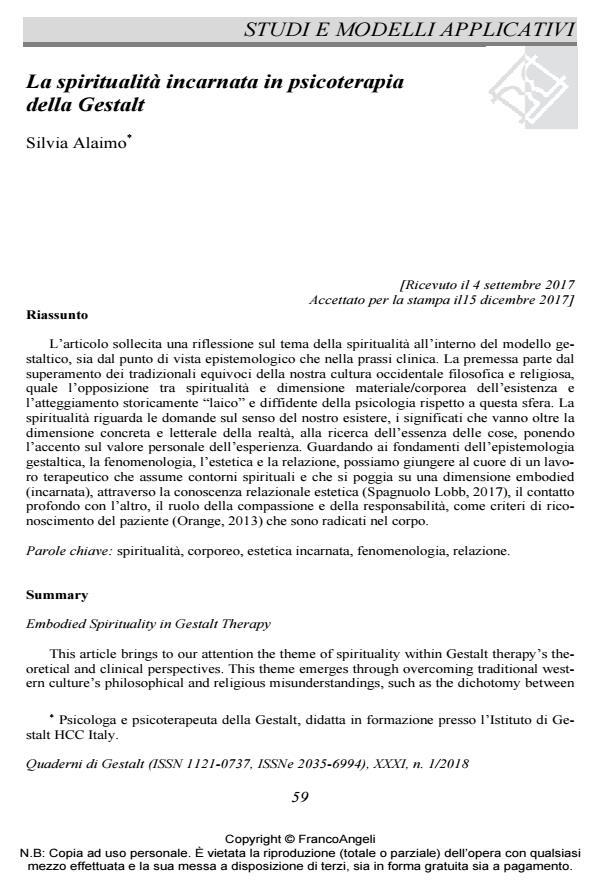Embodied Spirituality in Gestalt Therapy
Journal title QUADERNI DI GESTALT
Author/s Silvia Alaimo
Publishing Year 2018 Issue 2018/1 Language Italian
Pages 12 P. 59-70 File size 205 KB
DOI 10.3280/GEST2018-001005
DOI is like a bar code for intellectual property: to have more infomation
click here
Below, you can see the article first page
If you want to buy this article in PDF format, you can do it, following the instructions to buy download credits

FrancoAngeli is member of Publishers International Linking Association, Inc (PILA), a not-for-profit association which run the CrossRef service enabling links to and from online scholarly content.
This article brings to our attention the theme of spirituality within Gestalt therapy’s theoretical and clinical perspectives. This theme emerges through overcoming traditional western culture’s philosophical and religious misunderstandings, such as the dichotomy between spirituality and practical/material daily life as well as the widespread secular perspective of classic psychology. Spirituality deals with topics such as those that focus on a single individual’s experience in trying to fathom the true meaning of the things and moving beyond their mere concrete dimension. Through Gestalt therapy’s epistemology (phenomenology, aesthetics, relationship) we can get to the core of the therapeutic clinical practice that is based on the embodied dimension through the aesthetic experience of the individual (Spagnuolo Lobb, 2017), the deep contact with the other, and the role of compassion and responsibility as recognition criteria which are rooted in the patient’s body (see Orange, 2013).
Keywords: Spirituality, bodily, embodied aesthetics, phenomenology, relationship.
- Borino T. (2013). Il Training Autogeno in psicoterapia della Gestalt. Rilassamento, consapevolezza, vitalità. Quaderni di Gestalt, XXVI, 1: 109-123. DOI: 10.3280/GEST2013-001009
- Clement O., Serr J. (2015). La preghiera del cuore. Milano: Ancora (ed. or.: La prière du coeur, Abbaye De Bellefontaine, 2011).
- Damasio A. (2000). Emozione e Coscienza. Milano: Adelphi.
- Gallese V. (2008). Il corpo teatrale: mimetismo, neuroni specchio, simulazione incarnata. Culture teatrali, 16: 13-38.
- Gelin A. (1968). L’uomo secondo la Bibbia. Edizioni Ligel, testo disponibile sul sito: www.ora-et-labora.net.
- Erbuto D. (2014). Riflessioni sull’esperienza della corporeità: tra Leib e Körper. CorpoNarrante. Rivista online dell’IIFAB, Istituto Italiano di Formazione in Analisi Bioenergetica, 7. -- Testo disponibile sul sito: www.corponarrante.it.
- Irigaray L. (2011). Tra Oriente e Occidente. Dalla singolarità alla comunità. Roma: Manifestolibri (ed. or.: Entre Orient et Occident. Paris: Grasset, 1999).
- Mancuso V. (2010). Il corpo nella religione. Intervento nell’ambito della manifestazione dal titolo “Il corpo nella religione, sentire il Vuoto, sentire il Divino” (Modena 17/12/2010), trasposizione da audio registrazione non rivista dall’autore, -- http://www.vitomancuso.it/wp-content/uploads/2011/10/Il-corpo-nella-religione.pdf.
- Nelson J.M. (2009). Psychology, Religion, and Spirituality. New York, NY: Springer Science.
- Orange D. (2013). Dal riconoscimento alla responsabilità: la costituzione della soggettività. Conferenza Internazionale ISIPSE, Roma.
- Perls F.S., Hefferline R.F., Goodman P. (1997). Teoria e pratica della terapia della Gestalt: Vitalità e accrescimento nella personalità umana. Roma: Astrolabio (ed. or.: Gestalt Therapy: Excitement and Growth in the Human Personality. New York, NY: The Gestalt Journal Press, 1951; 1995).
- Roof, W. C. (1999). Spiritual Marketplace: Baby Boomers and the Remaking of American Religion. Princeton, NJ: Princeton University Press.
- Spagnuolo Lobb M. (2011). Il now-for-next in psicoterapia. La psicoterapia della Gestalt raccontata nella società post-moderna. Milano: FrancoAngeli.
- Spagnuolo Lobb M. (2013). Il corpo come “veicolo” del nostro essere nel mondo. L’esperienza corporea in psicoterapia della Gestalt. Quaderni di Gestalt, XXVI, 1: 41-65. DOI: 10.3280/GEST2013-001004
- Spagnuolo Lobb M. (2017). La conoscenza relazionale estetica del campo. Per uno sviluppo del concetto di consapevolezza in psicoterapia della Gestalt e nella clinica contemporanea. Quaderni di Gestalt, XXX, 1: 17-33. DOI: 10.3280/GEST2017-001003
- Staemmler F.M. (2007). On Macaque Monkeys, Players, and Clairvoyants: Some New Ideas for a Gestalt Therapeutic Concept of Empathy. Studies in Gestalt Therapy, 1 2: 43-639.
- Venturini R. (2010). Ri-legature buddhiste. Roma: Edizioni Universitarie Romane.
- Zinnbauer B.J., Pargament K.I., Scott A.B. (1999). The Emerging Meanings of Religiousness and Spirituality: Problems and Prospects. Journal of Personality, 67: 889-919.
- L'es in psicoterapia della Gestalt Mercurio Albino Macaluso, in QUADERNI DI GESTALT 1/2022 pp.47
DOI: 10.3280/GEST2022-001004 - Vitalità: psicoterapia, antropologia e spiritualità a confronto Stefano Boni, Stefania Consigliere, Salvatore Greco, Henry Herrera, Giulia Nora Pappalardo, Luca Pino, in QUADERNI DI GESTALT 2/2024 pp.11
DOI: 10.3280/GEST2023-002002
Silvia Alaimo, La spiritualità incarnata in psicoterapia della Gestalt in "QUADERNI DI GESTALT" 1/2018, pp 59-70, DOI: 10.3280/GEST2018-001005